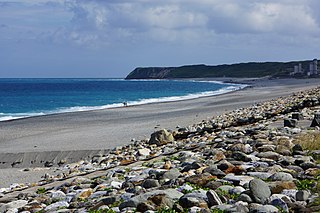Related Research Articles

Oden is a type of nabemono, consisting of several ingredients such as boiled eggs, daikon, konjac, and processed fishcakes stewed in a light, soy-flavored dashi broth.

Southern Min, Minnan or Banlam, is a group of linguistically similar and historically related Sinitic languages that form a branch of Min Chinese spoken in Fujian, most of Taiwan, Eastern Guangdong, Hainan, and Southern Zhejiang. The Minnan dialects are also spoken by descendants of emigrants from these areas in diaspora, most notably in Southeast Asia, such as Singapore, Malaysia, the Philippines, Indonesia, Brunei, Southern Thailand, Myanmar, Cambodia, Southern and Central Vietnam, San Francisco, Los Angeles and New York City. It is the most populous branch of Min Chinese, spoken by an estimated 48 million people in c. 2017–2018.

Taibao is a county-administered city and the county seat of Chiayi County, Taiwan.

Taiwanese Mandarin, Guoyu and colloquially as Huayu refers to Mandarin Chinese spoken in Taiwan. A large majority of the Taiwanese population is fluent in Mandarin, though many also speak a variety of Min Chinese known as Taiwanese Hokkien, commonly called Minnanyu, Southern Min, Taigi or Hokkien. This language has had a significant influence on Mandarin as spoken on the island.

Tongxiao Township is an urban township in southern Miaoli County, Taiwan. It lies between the Taiwan Strait on the west and mountains on the east.

Mudan Township (Chinese: 牡丹鄉; pinyin: Mǔdān Xiāng; Wade–Giles: Mu3-tan1 Hsiang1; Pe̍h-ōe-jī: Bó͘-tan-hiong) is a mountain indigenous township in Pingtung County, Taiwan. The main population is the Paiwan people of the Taiwanese aborigines.

Yuchi Township is a rural township in the center of Nantou County, Taiwan. It is the location of the Sun Moon Lake, a famous lake and tourist attraction in Taiwan.

Mount Xiuguluan is a mountain in Taiwan in Yushan National Park with an elevation of 3,825 m. It is located in Hualien County by the Xiuguluan River which has many tributaries such as Fuyuan River, Fengping River, and Lekuleku River, all nearby the river basin. It is the tallest mountain in the Central Mountain Range and the 6th tallest in Taiwan.

Mituo District is a rural district of Kaohsiung City in southern Taiwan.

Houtong is a railway station on the Taiwan Railways Administration Yilan line located in Ruifang District, New Taipei, Taiwan. Houtong once sat on top of Taiwan's largest coal mine, but now visitors come to see the numerous cats living in the town.

Xincheng Township or Sincheng Township is a rural township located in north of Hualien County, Taiwan, and has a population of 20,308 inhabitants and 8 villages. It is also the smallest township in Hualien County.

Xinzhuang District is a district in the western part of New Taipei in northern Taiwan. It has an area of 19.74 km2 (7.62 sq mi) and a population of 421,248 people.

Sandimen Township is a mountain indigenous township in Pingtung County, Taiwan Province, Republic of China. The population of the township consists mainly of the Paiwan people with a substantial Rukai minority.

Jiadong Township is a rural township in Pingtung County, Taiwan.

Huatan Township is a rural township in Changhua County, Taiwan.

Xiluo Township or Siluo Township is an urban township in Yunlin County, Taiwan.
Differing literary and colloquial readings for certain Chinese characters are a common feature of many Chinese varieties, and the reading distinctions for these linguistic doublets often typify a dialect group. Literary readings are usually used in loanwords, names, literary works, and in formal settings, while colloquial/vernacular readings are usually used in everyday vernacular speech.
The kezaixian is a bowed string instrument in the huqin family originating in China. More specifically a type of yehu, it is a two-stringed fiddle and is used in Taiwan opera.
The Dictionary of Frequently-Used Taiwan Minnan is a dictionary of Taiwanese Hokkien commissioned by the Ministry of Education of Taiwan. The dictionary uses the Taiwanese Romanization System to indicate pronunciations and includes audio files for many words. As of 2013, the dictionary included entries for 20,000 words.
References
- ↑ Jones, Russel (August 1959). "Chinese Names: Notes on the use of surnames & personal names by the Chinese in Malaya". Journal of the Malayan Branch of the Royal Asiatic Society. 32 (187). JSTOR 41505683.
- ↑ Hanks, Patrick; Coates, Richard; McClure, Peter, eds. (2016). The Oxford Dictionary of Family Names in Britain and Ireland. Oxford University Press. p. 2447. ISBN 9780192527479.
- ↑ "成". 臺灣閩南語常用詞辭典. 2011. Retrieved 10 January 2018.
- ↑ Medhurst, Walter Henry (1832). A dictionary of the Hok-këèn dialect of the Chinese language, according to the reading and colloquial idioms. East India Company Press. pp. 574.
- ↑ Fielde, Adele M. (1883). "成". A pronouncing and defining dictionary of the Swatow dialect, arranged according to syllables and tones. Shanghai: American Presbyterian Mission Press. p. 478. Additionally see "成". mogher.com. Retrieved 11 December 2019.
- ↑ "佘". 臺灣閩南語常用詞辭典. 2011. Retrieved 10 January 2018.
- ↑ Medhurst 1832 , p. 573
- ↑ Fielde 1883. Additionally see "佘". mogher.com. Retrieved 11 December 2019.
- ↑ "謝". 臺灣閩南語常用詞辭典. 2011. Retrieved 10 January 2018.
- ↑ Medhurst 1832 , p. 574
- ↑ Fielde 1883. Additionally see "謝". mogher.com. Retrieved 11 December 2019.
- ↑ Frank, Andrew (2005). Creeks and Southerners: Biculturalism on the Early American Frontier. University of Nebraska Press. ISBN 9780803220164.
- ↑ "How common is your last name?". Newsday. Retrieved 5 September 2018.